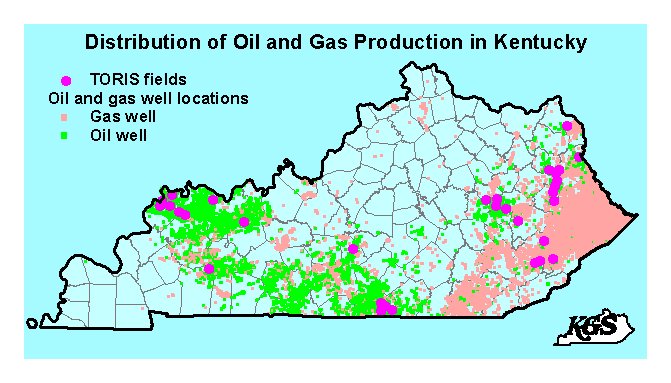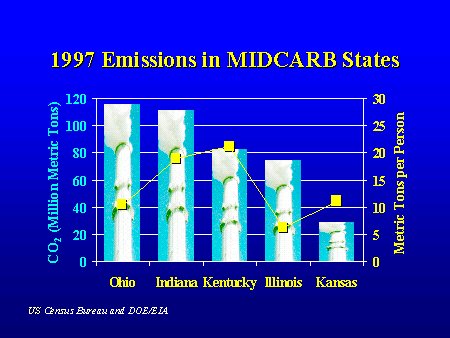
Contact: Carrie Pulliam

The world runs on fossil fuels and is likely to do so for a significant part of the 21st century. In the United States, coal is the primary fuel for electric power generation and petroleum is the transportation fuel of choice. Natural gas is an increasingly important fuel for the manufacturing industry, electrical utilities, and transportation. (See the Energy Information Administration of the U.S. Department of Energy for resource and usage information.) One of the by-products of burning fossil fuels is the release of CO2 (carbon dioxide), a greenhouse gas, into the atmosphere. The increase in atmospheric CO2 is being linked by some scientists to global warming. Three strategies are available for managing the amount of CO2 released to the atmosphere:
It will be several decades before carbon-free fuels become widely available. Conservation measures will help, but increased demand for energy, especially in developing countries, will diminish their beneficial effects. While alternate fuel and conservation strategies are being developed and implemented, long-term storage options will be needed for successful carbon management.
The goal of the Midcontinent Interactive Digital Carbon Atlas and Relational Database (MIDCARB) project is to construct a database and geographic information system for use in evaluating the distribution and physical characteristics of potential CO2 sources and geologic sequestration sites.
In 1997, Kentucky's coal-fired power plants emitted more than 82.5 million metric tons of CO2 (seventh overall in the United States). Kentucky is a net exporter of power and because of its relatively low population, the state has the highest CO2 emissions per capita of the MIDCARB member states: Illinois, Indiana, Kansas, Kentucky, and Ohio. In Kentucky, CO2 sequestration potential exists in three recognized types of geologic sinks:
Additional potential unconventional sequestration sites warranting assessment are:

|
Click on chart to visit MIDCARB state surveys and the information |
Existing oil and gas fields represent one of Kentucky's primary opportunities for sequestration. There are an estimated 1.7 billion barrels of original mobile oil-in-place (OOIP) in 46 of the largest reservoirs in Kentucky (see TORIS). Of this amount, at least 170 million to 250 million barrels of oil remains for primary and secondary recovery. A successful, immiscible CO2 flood in eastern Kentucky increased oil production in the field by 23 percent. An estimated 50 percent of the CO2 used in that flood remained sequestered in the formation. As an economic benefit, CO2 flooding could be expected to boost statewide annual oil production by 10 to 15 percent to about 3.45 million barrels. Enhanced recovery projects designed to maximize CO2 sequestration could use approximately 20 percent of the CO2 emitted in the state.
The organic-rich fractured Devonian black shales and Pennsylvanian coal beds of Kentucky are additional possible sites for carbon sequestration. The state produces about 80 billion cubic feet (bcf) of natural gas per year; most is from the Devonian shales in the Appalachian Basin of eastern Kentucky. An estimated 8 trillion cubic feet (tcf) of CO2 could be sequestered in the shale to replace natural gas already produced. In the state's coal basins, there are an estimated 283 bcf of coalbed methane gas-in-place. For the shale and coals, using a recovery factor for natural gas of 17 percent, 5 tcf remain savailable for primary production and approximately 50 tcf available for enhanced recovery. CO2 sequestration in these reservoirs could result in an additional 30 bcf in annual production for natural gas in Kentucky and sequestration of 60 bcf CO2 annually. At this rate, in 10 years, as much as 31.8 million metric tons of CO2 could be sequestered.
The sequestration of CO2 in saline aquifers is also possible in many parts of Kentucky. Several deep saline aquifers are present in the Appalachian and Illinois Basins. The Cambrian Mt. Simon Sandstone has been used for deep-well disposal in Ohio, as has the Cambrian-Ordovician Knox Group in Kentucky. Other formations, such as parts of the Middle Proterozoic Middle Run Formation, could be considered for sequestration in the vicinity of the Cincinnati Arch and the Illinois Basin of central and western Kentucky. Capacities for CO2 sequestration in these formations are unknown.